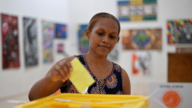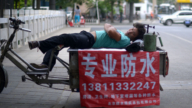設立於東印度加爾各答(Kolkata)的國家矯治收容所(Presidency Correctional Home),將舞蹈納入矯治課程,讓受刑人在獄中接受各種舞蹈訓練。參加舞蹈訓練的受刑人都表示,這項措施讓歡笑重回到他們的生命。
位於印度東方的西孟加拉邦(West Bengal),當地邦政府在過去五年來,持續推動讓囚犯享有尊嚴的牢獄生活,不僅在形式上將監獄的名稱,更改為矯治收容所,實際上,更採用各種方法鼓勵受刑人從事有意義的活動。舞蹈訓練課程,就是其中的方法之一。
擔任受刑人舞蹈訓練師的阿蘿卡萳達‧蕾(Alokananda Ray),親眼看到了受刑人的巨大轉變。對於許多年輕的囚犯而言,蕾不僅僅只是一位舞蹈治療師,更像是他們的母親一樣。對於受刑人能在舞蹈節慶中,登上舞臺公開演出一事,蕾感到很驕傲,也創下了世界首例。為了讓受刑人對於舞蹈訓練課程更感興趣,獄方對於舞蹈的種類不作限制。
接受舞蹈訓練的受刑人都表示,對他們而言,監獄現在變成了可愛的家,舞蹈不僅能自娛,更讓他們的身心受益。
新唐人亞太電視 王士傑 編譯
===================================================
SUBCONEARLY-MAY04-INDIA-DANCE THERAPY
SUBCONEARLY: STORY SU703
DANCE THERAPY
KOLKATA, WEST BENGAL, INDIA
MAY 04, 2008
NATURAL WITH ENGLISH SPEECH
DURATION:02:03
SOURCE:ANI
FEED HISTORY:SUBCONEARLY
INTRO: Prisoners take to dance therapy in eastern India.
TV AND WEB RESTRICTIONS~**NONE**~
Prisoners being trained in various performing dances at Presidency jail in
India’s eastern Kolkata as part of the reform process.
SHOWS:
KOLKATA (MAY 04, 2008) (ANI-ACCESS ALL)
1.OUTSIDE OF PRESIDENCY JAIL
2.PRISONERS LEARNING DANCE
3.A WOMAN STANDING
4.(SOUNDBITE) (English) ALOKANANDA RAY, TRAINER, SAYING:
“Initially none of the prisoners could move a step. It’s a pity
that people don’t see the beginning they (people) only see the finished
product. If they did, they would see the tremendous physical transformation,
which can only come through internal transformation."
5.TWO DANCERS DANCING
6.(SOUNDBITE) (English) NAIZAL AXARA, PRISONER, SAYING:
“The greatest thing that I have received from this dance is the
happiness and the smile on my face. I had no smile on my face for the past few
years. This is the greatest thing that I have received."
7.PRISONERS DANCING TOGETHER
8.THREE PRISONERS DANCING IN A ROW
9.A PRISONER DANCING WITH PEOPLE STANDING AROUND
STORY: Prisoners at Presidency jail also known as Presidency Correctional
Home in India’s eastern Kolkata are being trained in various performing dances
as part of the reform process.
The state Government in India’s eastern West Bengal has been working for
the last five years to offer a respectable life to prisoners. Besides jails
being termed correctional homes, the government is adopting various methods to
engage prisoners in constructive activities and transform all jails into
correctional homes.
Odissi dancer, Alokananda Ray has been training over 50 prisoners in the
jail for the past one year and has witnessed a tremendous change in the
convicts.
Alokananda says she feels she is not simply a therapist but a motherly
figure to the young boys at the prison.
She adds with pride that these prisoners trained by her performed in a
dance festival and it was for the first time in the world that prisoners
staged a public performance.
To generate the interest of the prisoners, Alokananda opted for martial
dance forms like Kalaripattu and Chhau, which have bold music and manly steps
instead of Indian classical dance. But now the jail inmates are open to all
kinds of dances.
“Initially none of the prisoners could move a step. It’s a pity that
people don’t see the beginning they (people) only see the finished product. If
they did, they would see the tremendous physical transformation, which can
only come through internal transformation," said Alokananda Ray,
trainer.
The prisoners feel that with the learning of dance forms happiness has
returned into their lives.
“The greatest thing that I have received from this dance is the
happiness and the smile on my face. I had no smile on my face for the past few
years. This is the greatest thing that I have received," said Naizal
Axara, Prisoner.
The prisoners acknowledge that the dance has turned their prison cell into
a lively home. They also say that it is the only ray of hope in their lives to
look forward. Besides entertaining them, the rhythm, music and dance movements
have contributed to their mental and physical well-being.
RGDS,
NNNN

























